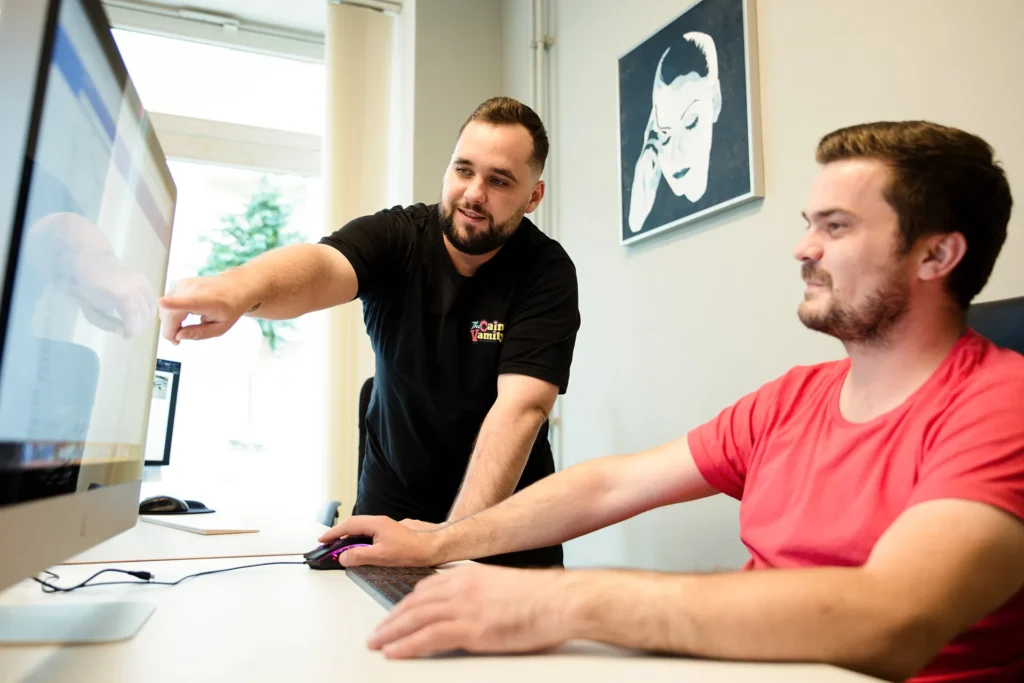OnPage SEO für eine bessere Sichtbarkeit Ihrer Webseite
Holen Sie sich die Aufmerksamkeit, die Sie verdienen
Warum ist OnPage SEO wichtig?
Die OnPage-Optimierung bezieht sich auf alle Maßnahmen, die Sie auf Ihrer eigenen Webseite durchführen, um sicherzustellen, dass sie für Suchmaschinen wie Google optimiert ist und dass die Inhalte für die Besucher Ihrer Seite relevant und nützlich sind.
Durch eine gut durchgeführte OnPage-Optimierung können Sie sicherstellen, dass Ihre Webseite bei relevanten Suchanfragen in den Suchmaschinenergebnissen angezeigt wird und dass Besucher auf Ihrer Webseite bleiben und sich mit Ihrem Unternehmen und Ihren Inhalten beschäftigen.
Schritt für Schritt zur erfolgreichen OnPage-Optimierung
Analyse der Webseite
Zu Beginn einer erfolgreichen OnPage-Optimierung steht die Analyse Ihrer Webseite. Hierbei geht es darum, Schwachstellen und Potenziale zu identifizieren.
Eine solide Basis für die Optimierung ist eine gründliche Analyse Ihrer Webseite. Hierbei sollten Sie sich unter anderem folgende Fragen stellen: Wie schnell lädt meine Webseite? Sind alle wichtigen Inhalte vorhanden und übersichtlich strukturiert? Welche Inhalte werden von Besuchern am häufigsten aufgerufen?
Keyword-Recherche
Als nächstes erfolgt die Keyword-Recherche. Hierbei geht es darum, passende Keywords für Ihre Webseite zu finden, die in den Inhalten verwendet werden sollen.
Achten Sie darauf, dass die Keywords relevant für das Angebot Ihrer Webseite sind und auch von potenziellen Kunden gesucht werden. Eine gute Keyword-Recherche ist die Grundlage für eine erfolgreiche OnPage-Optimierung.
Unique Content
Die Keywords müssen jetzt in den Content (Inhalt) eingebaut werden. Unique Content ist ein wichtiger Begriff im Bereich des Online-Marketings.
Er beschreibt Inhalte, die einzigartig und originell sind und nicht einfach von anderen Webseiten kopiert oder dupliziert wurden.
Durch Unique Content kann eine Webseite sich von anderen unterscheiden und eine höhere Relevanz bei Suchmaschinen erzielen.
Es geht aber nicht nur um Suchmaschinenoptimierung. Einzigartige Inhalte können auch das Interesse der Leser wecken und sie dazu bringen, länger auf der Seite zu bleiben oder sogar zurückzukehren.
Daher ist es wichtig, dass Unternehmen Zeit und Ressourcen investieren, um qualitativ hochwertige Inhalte zu erstellen, die ihre Zielgruppe ansprechen.

OnPage Optimierung der Inhalte
Optimierung ist die Optimierung der Inhalte auf Ihrer Webseite. Gestalten sie Ihre Inhalte so, dass sie von Suchmaschinen und Besuchern gut verstanden werden. Dazu gehören unter anderem:
- Überschriften und Textstruktur: Eine klare Strukturierung Ihrer Inhalte durch Überschriften und Absätze erleichtert Besuchern das Lesen und Suchmaschinen das Auslesen der Inhalte.
- Meta-Daten: Meta-Titel und Meta-Beschreibungen sind wichtige Elemente für eine erfolgreiche OnPage Optimierung. Sie sollten darauf achten, dass diese Elemente aussagekräftig und relevant für Ihre Webseite sind.
- Bildoptimierung: Auch Bilder sollten für Suchmaschinen optimiert werden. Dazu gehört unter anderem die Verwendung von aussagekräftigen Dateinamen und Alt-Tags. Ein Alt-Tag ist eine kurze Beschreibung, die es Suchmaschinen und Besuchern mit Sehbehinderungen erleichtern, den Inhalt des Bildes zu verstehen.
Technische OnPage-Optimierung
Die technische OnPage-Optimierung ist ein weiterer wichtiger Teil der Optimierung Ihrer Webseite. Hierbei geht es um technische Faktoren, die Einfluss auf die Bewertung Ihrer Webseite durch Suchmaschinen haben. Dazu gehören unter anderem:
- Ladezeitoptimierung: Eine schnelle Ladezeit Ihrer Webseite ist ein wichtiger Faktor für eine erfolgreiche OnPage-Optimierung. Zu lange Ladezeiten können dazu führen, dass Besucher Ihre Webseite wieder verlassen.
- Mobile Optimierung: Immer mehr Menschen nutzen mobile Geräte wie Smartphones und Tablets zum Surfen im Internet. Eine gute mobile Optimierung Ihrer Webseite ist daher unerlässlich.
- Sicherheitsaspekte:
Sicherheit ist ein weiterer wichtiger Faktor bei der OnPage-Optimierung. Hier geht es darum, deine Webseite vor Hackern und anderen Angriffen zu schützen und sicherzustellen, dass du und deine Besucher sich sicher fühlen. Zu den Sicherheitsaspekten gehören unter anderem:
- SSL-Zertifikat: Ein SSL-Zertifikat verschlüsselt die Daten, die zwischen Ihrer Webseite und dem Browser des Besuchers ausgetauscht werden. Dadurch wird sichergestellt, dass die Daten nicht von Dritten abgefangen oder manipuliert werden können.
- Sichere Passwörter: Sichere Passwörter sind unerlässlich, um Ihre Webseite und Ihre Daten vor Hackern zu schützen. Verwenden Sie komplexe Passwörter die aus Buchstaben, Zahlen und Sonderzeichen bestehen.
- Regelmäßige Backups: Regelmäßige Backups sind wichtig um sicherzustellen, dass Sie im Falle eines Hackerangriffs oder eines anderen Problems immer eine aktuelle Version Ihrer Webseite zur Verfügung haben.
Weitere Faktoren
Linkaufbau
Auch der Linkaufbau spielt bei der OnPage-Optimierung eine wichtige Rolle. Hierbei geht es darum, interne und externe Verlinkungen zu optimieren, um die Webseite für Suchmaschinen besser zugänglich zu machen.
Interne Verlinkung:
Eine gute interne Verlinkung sorgt dafür, dass Nutzer und Suchmaschinen sich auf der Webseite besser zurechtfinden. Dabei sollte man darauf achten, dass die Verlinkungen sinnvoll und relevant sind und nicht übertrieben werden.
Externe Verlinkung:
Auch externe Verlinkungen spielen eine wichtige Rolle bei der OnPage Optimierung. Dabei geht es darum, Backlinks von anderen Websites zu generieren, um die eigene Webseite als relevant und vertrauenswürdig zu positionieren. Allerdings sollten Backlinks immer natürlichen Ursprungs sein und nicht künstlich generiert werden, um Abstrafungen von Suchmaschinen zu vermeiden.
Monitoring und Optimierung
Eine erfolgreiche OnPage-Optimierung ist kein einmaliger Prozess, sondern erfordert eine kontinuierliche Überwachung und Optimierung. Hierbei geht es darum, regelmäßig die Performance der Webseite zu überprüfen und auf Veränderungen in den Suchmaschinen-Algorithmen zu reagieren. Nur so kann man sicherstellen, dass die Webseite immer auf dem neuesten Stand bleibt und auch langfristig erfolgreich ist.
Hier kommen wir ins Spiel!
Leider ist auch die beste Optimierung einer Webseite kein einmaliger Prozess. Bei der OnPage-Optimierung machen wir eine professionelle Analyse Ihrer Webseite und durch unseren SEO-Check achten wir auf die Faktoren, die im Ranking wichtig sind.
Stellt Google ein neues Update vor, kennen wir es. Das Gleiche gilt für andere wichtige Suchmaschinen. Darüber hinaus gewinnen wir in der täglichen Anwendung laufend Erkenntnisse über Neuerungen bei den Anbietern von Suchmaschinen.
Die Suchmaschinen arbeiten unaufhörlich an ihren Algorithmen und verändern diese. Deshalb heißt es bei der OnPage-Optimierung ständig auf dem Laufenden zu bleiben.
Vereinbaren Sie jetzt einfach ein Beratungstermin. Wir freuen uns auf Sie.
Vereinbaren Sie einen Beratungstermin!
Sie erreichen uns telefonisch Mo – Fr von 9:00 – 18:00 Uhr unter
+49 (0) 30 / 629 33 92 90 oder per Kontaktformular.
Wir freuen uns auf Sie.
